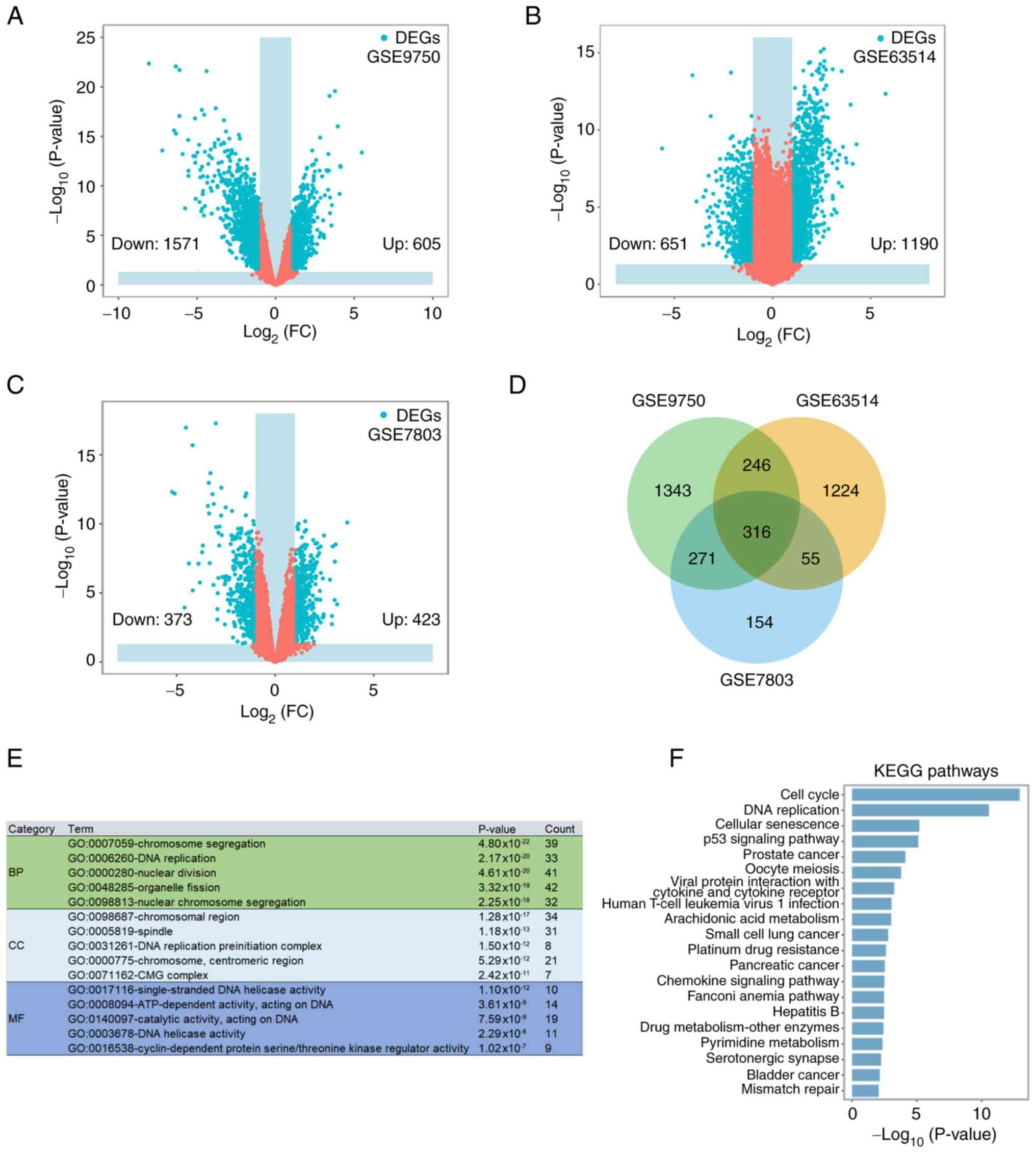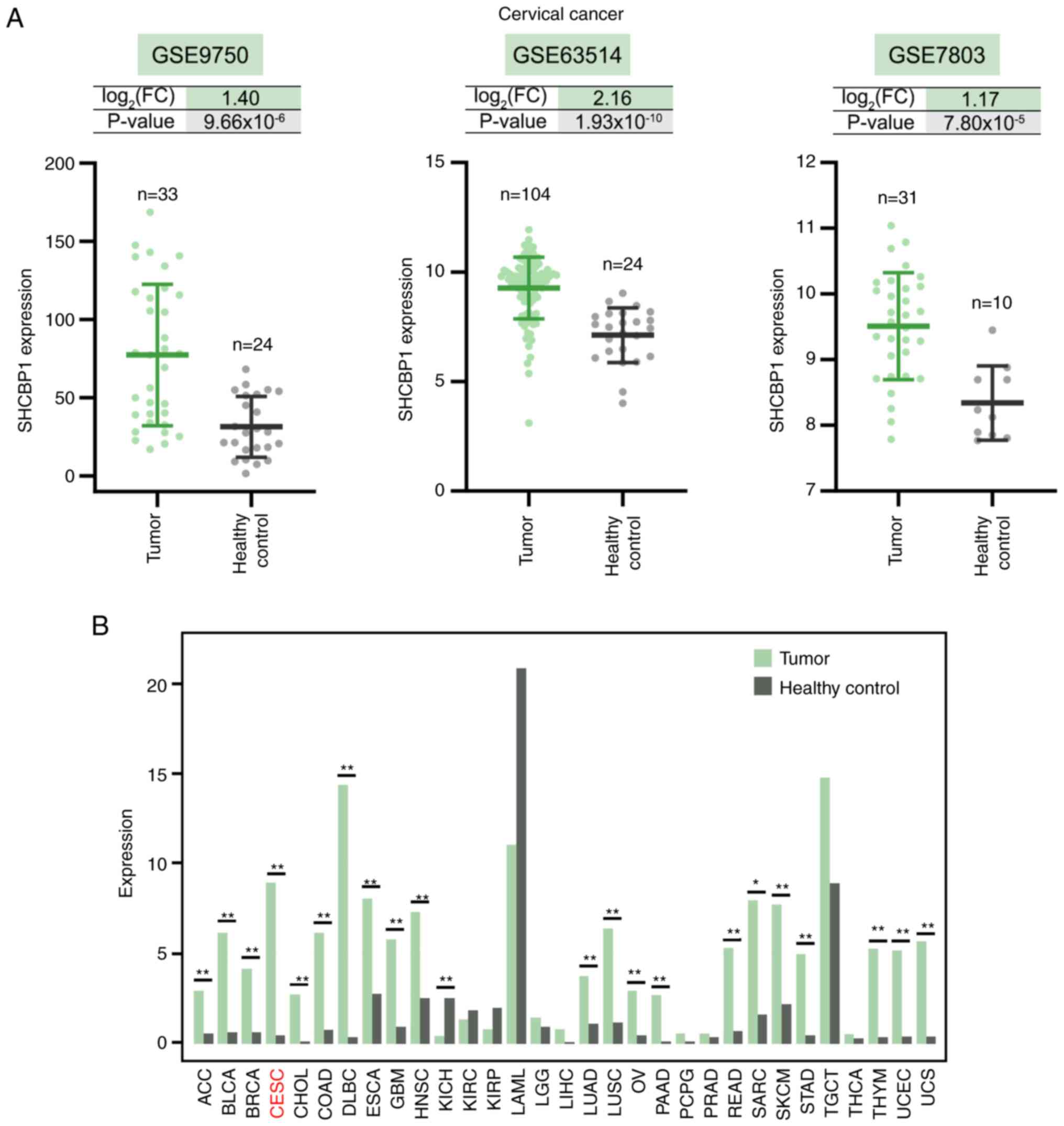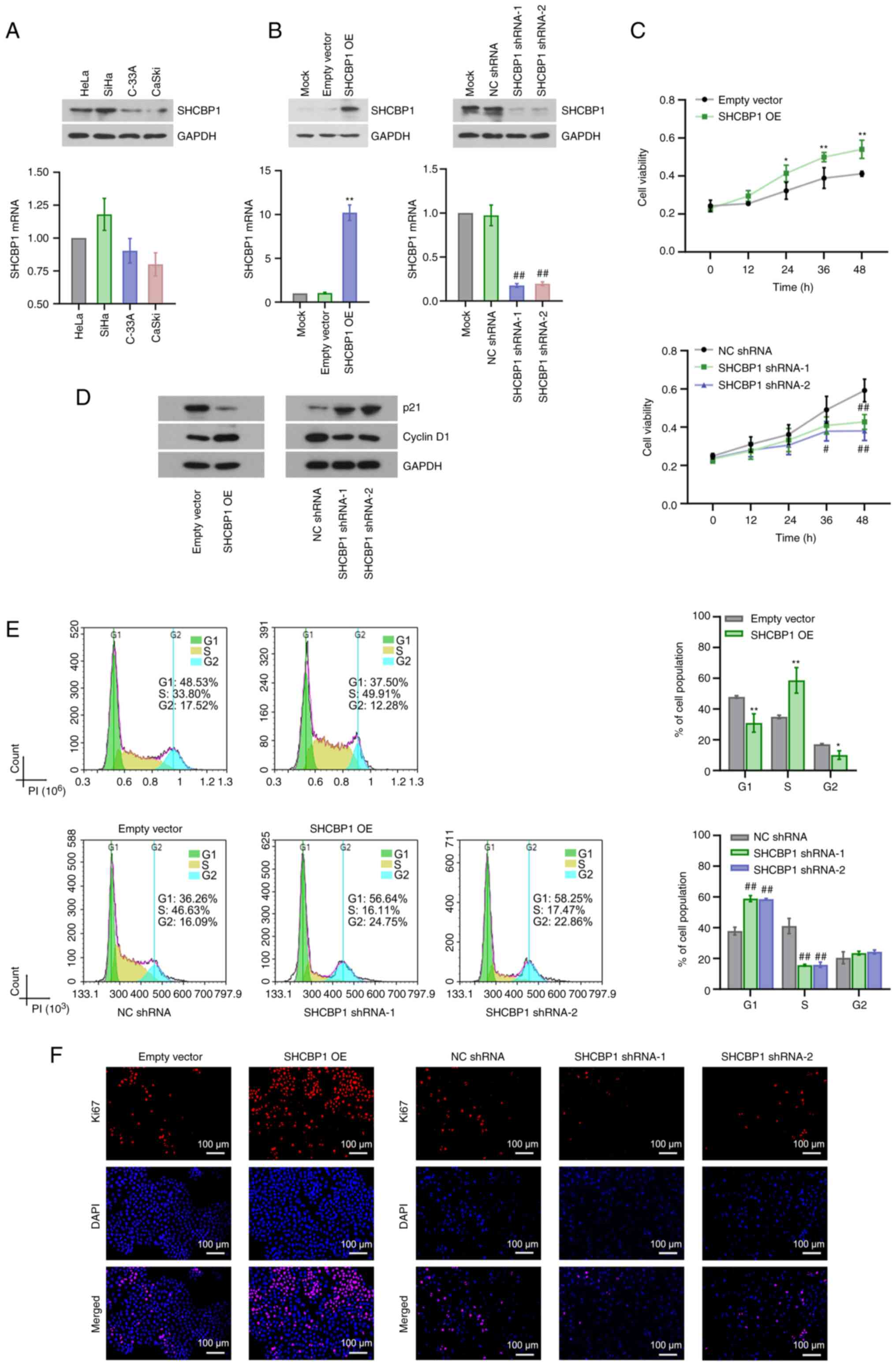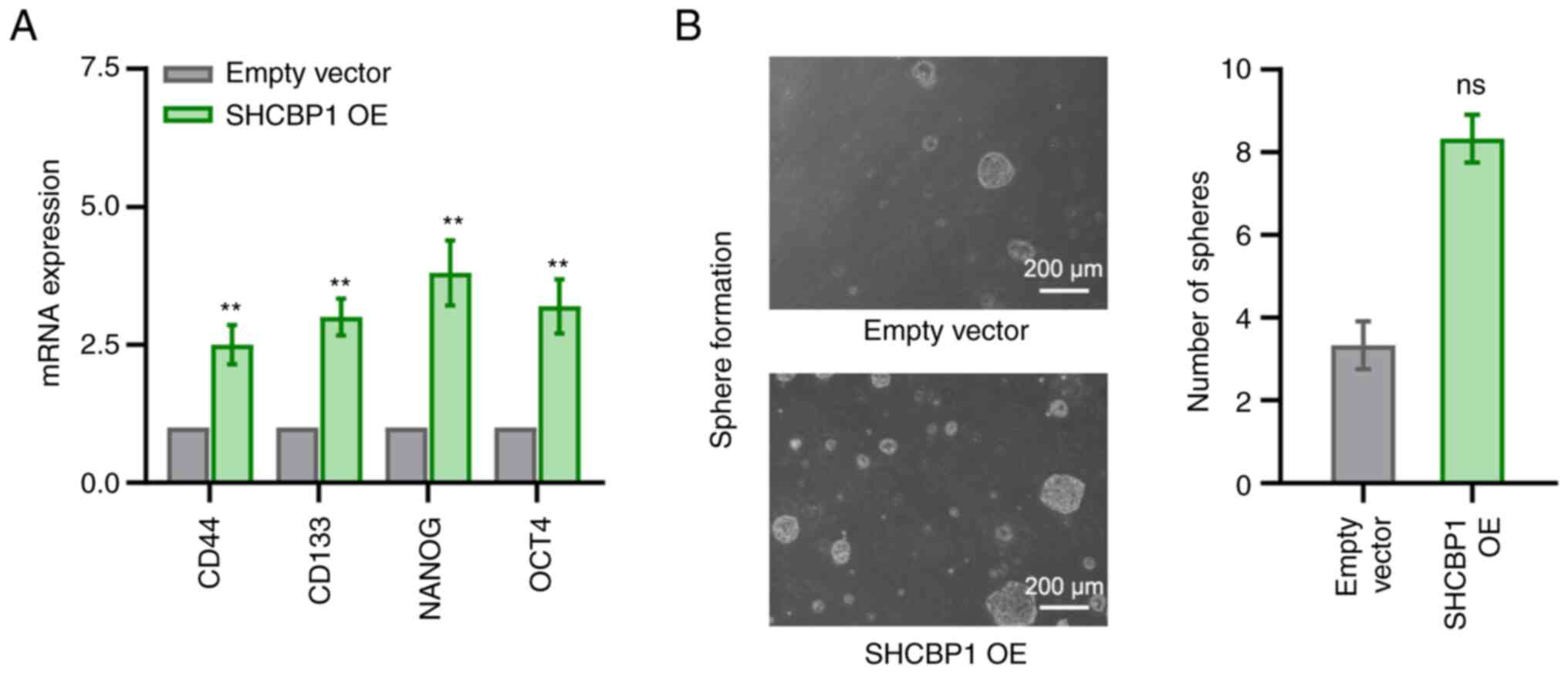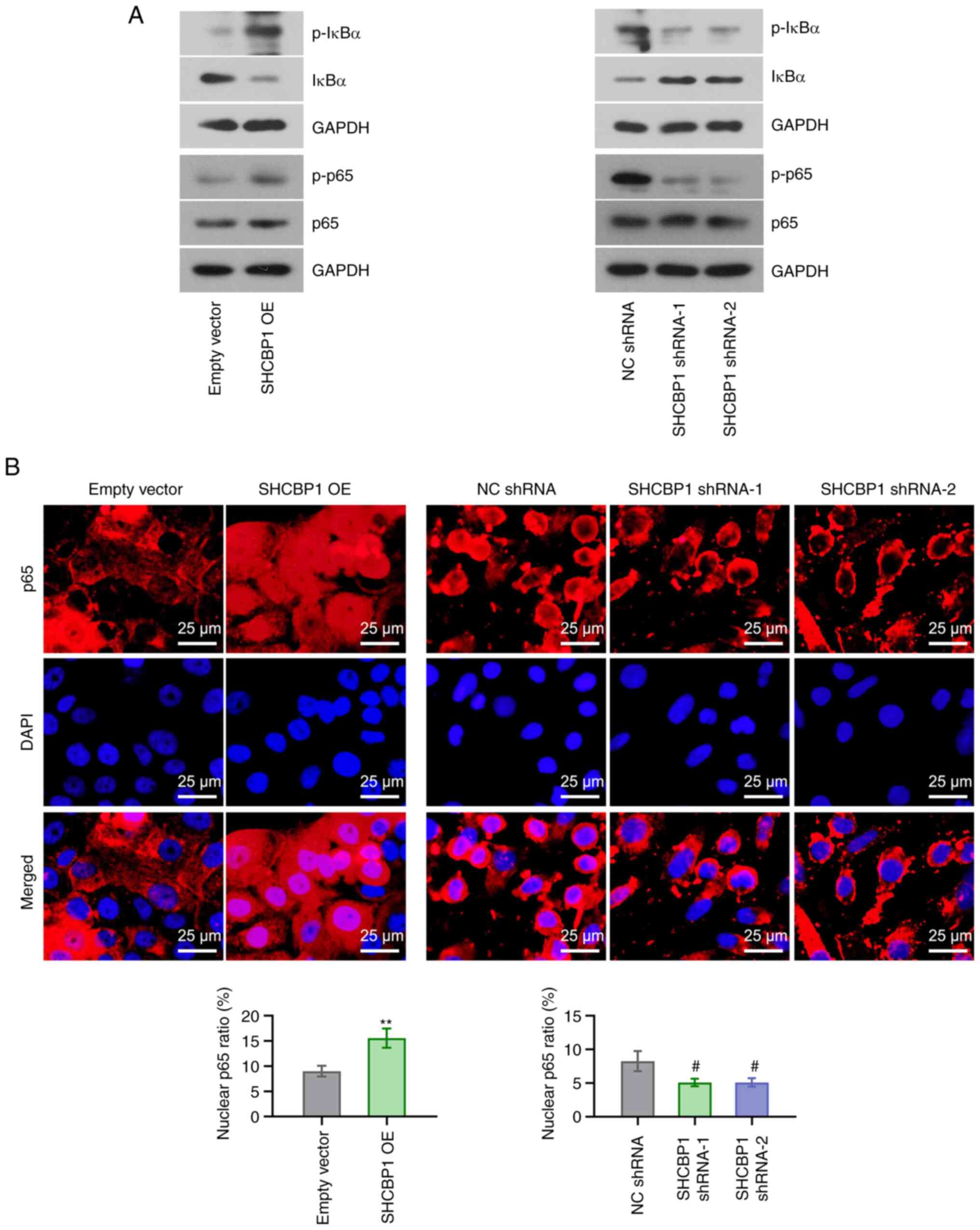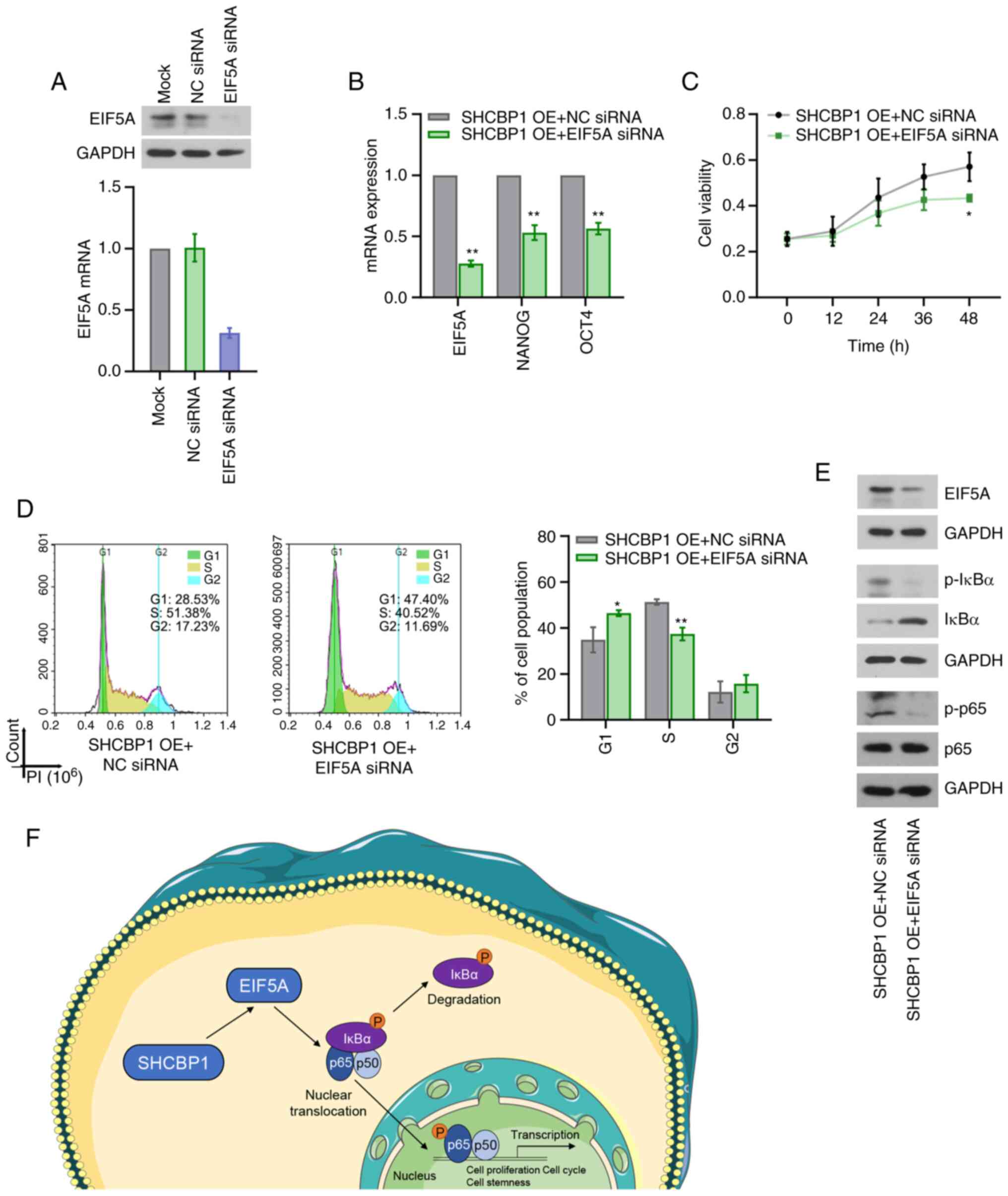|
1
|
Sung H, Ferlay J, Siegel RL, Laversanne M,
Soerjomataram I, Jemal A and Bray F: Global cancer statistics 2020:
GLOBOCAN estimates of incidence and mortality worldwide for 36
cancers in 185 countries. CA Cancer J Clin. 71:209–249. 2021.
View Article : Google Scholar : PubMed/NCBI
|
|
2
|
Brisson M and Drolet M: Global elimination
of cervical cancer as a public health problem. Lancet Oncol.
20:319–321. 2019. View Article : Google Scholar : PubMed/NCBI
|
|
3
|
Brisson M, Kim JJ, Canfell K, Drolet M,
Gingras G, Burger EA, Martin D, Simms KT, Bénard É, Boily MC, et
al: Impact of HPV vaccination and cervical screening on cervical
cancer elimination: A comparative modelling analysis in 78
low-income and lower-middle-income countries. Lancet. 395:575–590.
2020. View Article : Google Scholar : PubMed/NCBI
|
|
4
|
Schmandt R, Liu SK and McGlade CJ: Cloning
and characterization of mPAL, a novel Shc SH2 domain-binding
protein expressed in proliferating cells. Oncogene. 18:1867–1879.
1999. View Article : Google Scholar : PubMed/NCBI
|
|
5
|
Li D, Peng H, Qu L, Sommar P, Wang A, Chu
T, Li X, Bi X, Liu Q, Sérézal IG, et al: MiR-19a/b and miR-20a
promote wound healing by regulating the inflammatory response of
keratinocytes. J Invest Dermatol. 141:659–671. 2021. View Article : Google Scholar : PubMed/NCBI
|
|
6
|
Shi W, Zhang G, Ma Z, Li L, Liu M, Qin L,
Yu Z, Zhao L, Liu Y, Zhang X, et al: Hyperactivation of
HER2-SHCBP1-PLK1 axis promotes tumor cell mitosis and impairs
trastuzumab sensitivity to gastric cancer. Nat Commun. 12:28122021.
View Article : Google Scholar : PubMed/NCBI
|
|
7
|
Peng C, Zhao H, Song Y, Chen W, Wang X,
Liu X, Zhang C, Zhao J, Li J, Cheng G, et al: SHCBP1 promotes
synovial sarcoma cell metastasis via targeting TGF-beta1/Smad
signaling pathway and is associated with poor prognosis. J Exp Clin
Cancer Res. 36:1412017. View Article : Google Scholar : PubMed/NCBI
|
|
8
|
Liu L, Yang Y, Liu S, Tao T, Cai J, Wu J,
Guan H, Zhu X, He Z, Li J, et al: EGF-induced nuclear localization
of SHCBP1 activates beta-catenin signaling and promotes cancer
progression. Oncogene. 38:747–764. 2019. View Article : Google Scholar : PubMed/NCBI
|
|
9
|
Wullaert A, Bonnet MC and Pasparakis M:
NF-κB in the regulation of epithelial homeostasis and inflammation.
Cell Res. 21:146–158. 2011. View Article : Google Scholar : PubMed/NCBI
|
|
10
|
Ghosh S and Hayden MS: New regulators of
NF-kappaB in inflammation. Nat Rev Immunol. 8:837–848. 2008.
View Article : Google Scholar : PubMed/NCBI
|
|
11
|
Wu Z, Peng X, Li J, Zhang Y and Hu L:
Constitutive activation of nuclear factor kappaB contributes to
cystic fibrosis transmembrane conductance regulator expression and
promotes human cervical cancer progression and poor prognosis. Int
J Gynecol Cancer. 23:906–915. 2013. View Article : Google Scholar : PubMed/NCBI
|
|
12
|
Wang J, Ou J, Guo Y, Dai T, Li X, Liu J,
Xia M, Liu L and He M: TBLR1 is a novel prognostic marker and
promotes epithelial-mesenchymal transition in cervical cancer. Br J
Cancer. 111:112–124. 2014. View Article : Google Scholar : PubMed/NCBI
|
|
13
|
Wang W, Li X, Xu Y, Guo W, Yu H, Zhang L,
Wang Y and Chen X: Acetylation-stabilized chloride intracellular
channel 1 exerts a tumor-promoting effect on cervical cancer cells
by activating NF-kappaB. Cell Oncol (Dordr). 44:557–568. 2021.
View Article : Google Scholar : PubMed/NCBI
|
|
14
|
Zhou Y, Tan Z, Chen K, Wu W, Zhu J, Wu G,
Cao L, Zhang X, Zeng X, Li J and Zhang W: Overexpression of SHCBP1
promotes migration and invasion in gliomas by activating the
NF-kappaB signaling pathway. Mol Carcinog. 57:1181–1190. 2018.
View Article : Google Scholar : PubMed/NCBI
|
|
15
|
Coni S, Serrao SM, Yurtsever ZN, Magno LD,
Bordone R, Bertani C, Licursi V, Ianniello Z, Infante P, Moretti M,
et al: Blockade of EIF5A hypusination limits colorectal cancer
growth by inhibiting MYC elongation. Cell Death Dis. 11:10452020.
View Article : Google Scholar : PubMed/NCBI
|
|
16
|
Wang Z, Jiang J, Qin T, Xiao Y and Han L:
EIF5A regulates proliferation and chemoresistance in pancreatic
cancer through the sHH signalling pathway. J Cell Mol Med.
23:2678–2688. 2019. View Article : Google Scholar : PubMed/NCBI
|
|
17
|
Mémin E, Hoque M, Jain MR, Heller DS, Li
H, Cracchiolo B, Hanauske-Abel HM, Pe'ery T and Mathews MB:
Blocking eIF5A modification in cervical cancer cells alters the
expression of cancer-related genes and suppresses cell
proliferation. Cancer Res. 74:552–562. 2014. View Article : Google Scholar : PubMed/NCBI
|
|
18
|
Liu Z, Teng L, Gao L, Wang H, Su Y and Li
J: The role of eukaryotic translation initiation factor 5A-1
(eIF5A-1) gene in HPV 16 E6 induces cell growth in human cervical
squamous carcinoma cells. Biochem Biophys Res Commun. 504:6–12.
2018. View Article : Google Scholar : PubMed/NCBI
|
|
19
|
Taylor CA, Liu Z, Tang TC, Zheng Q,
Francis S, Wang TW, Ye B, Lust JA, Dondero R and Thompson JE:
Modulation of eIF5A expression using SNS01 nanoparticles inhibits
NF-κB activity and tumor growth in murine models of multiple
myeloma. Mol Ther. 20:1305–1314. 2012. View Article : Google Scholar : PubMed/NCBI
|
|
20
|
Geng H, Guo M, Xu W, Zang X, Wu T, Teng F,
Wang Y, Liu X, Wang X, Sun Q and Liang J: SHCBP1 promotes papillary
thyroid carcinoma carcinogenesis and progression through promoting
formation of integrin and collagen and maintaining cell stemness.
Front Endocrinol (Lausanne). 11:6138792021. View Article : Google Scholar : PubMed/NCBI
|
|
21
|
Scotto L, Narayan G, Nandula SV,
Arias-Pulido H, Subramaniyam S, Schneider A, Kaufmann AM, Wright
JD, Pothuri B, Mansukhani M and Murty VV: Identification of copy
number gain and overexpressed genes on chromosome arm 20q by an
integrative genomic approach in cervical cancer: Potential role in
progression. Genes Chromosomes Cancer. 47:755–765. 2008. View Article : Google Scholar : PubMed/NCBI
|
|
22
|
den Boon JA, Pyeon D, Wang SS, Horswill M,
Schiffman M, Sherman M, Zuna RE, Wang Z, Hewitt SM, Pearson R, et
al: Molecular transitions from papillomavirus infection to cervical
precancer and cancer: Role of stromal estrogen receptor signaling.
Proc Natl Acad Sci USA. 112:E3255–E3264. 2015. View Article : Google Scholar : PubMed/NCBI
|
|
23
|
Zhai Y, Kuick R, Nan B, Ota I, Weiss SJ,
Trimble CL, Fearon ER and Cho KR: Gene expression analysis of
preinvasive and invasive cervical squamous cell carcinomas
identifies HOXC10 as a key mediator of invasion. Cancer Res.
67:10163–10172. 2007. View Article : Google Scholar : PubMed/NCBI
|
|
24
|
Livak KJ and Schmittgen TD: Analysis of
relative gene expression data using real-time quantitative PCR and
the 2(−Delta Delta C(T)) method. Methods. 25:402–408. 2001.
View Article : Google Scholar : PubMed/NCBI
|
|
25
|
Mirzaei S, Saghari S, Bassiri F, Raesi R,
Zarrabi A, Hushmandi K, Sethi G and Tergaonkar V: NF-κB as a
regulator of cancer metastasis and therapy response: A focus on
epithelial-mesenchymal transition. J Cell Physiol. 237:2770–2795.
2022. View Article : Google Scholar : PubMed/NCBI
|
|
26
|
Strnadel J, Choi S, Fujimura K, Wang H,
Zhang W, Wyse M, Wright T, Gross E, Peinado C, Park HW, et al:
eIF5A-PEAK1 signaling regulates YAP1/TAZ protein expression and
pancreatic cancer cell growth. Cancer Res. 77:1997–2007. 2017.
View Article : Google Scholar : PubMed/NCBI
|
|
27
|
Tian M, Neil JR and Schiemann WP:
Transforming growth factor-β and the hallmarks of cancer. Cell
Signal. 23:951–962. 2021. View Article : Google Scholar : PubMed/NCBI
|
|
28
|
Bertoli C, Skotheim JM and de Bruin RA:
Control of cell cycle transcription during G1 and S phases. Nat Rev
Mol Cell Biol. 14:518–528. 2013. View Article : Google Scholar : PubMed/NCBI
|
|
29
|
Mo M, Tong S, Yin H, Jin Z, Zu X and Hu X:
SHCBP1 regulates STAT3/c-Myc signaling activation to promote tumor
progression in penile cancer. Am J Cancer Res. 10:3138–3156.
2020.PubMed/NCBI
|
|
30
|
Yang C, Hu JF, Zhan Q, Wang ZW, Li G, Pan
JJ, Huang L, Liao CY, Huang Y, Tian YF, et al: SHCBP1 interacting
with EOGT enhances O-GlcNAcylation of NOTCH1 and promotes the
development of pancreatic cancer. Genomics. 113:827–842. 2021.
View Article : Google Scholar : PubMed/NCBI
|
|
31
|
Xu N, Wu YP, Yin HB, Chen SH, Li XD, Xue
XY and Gou X: SHCBP1 promotes tumor cell proliferation, migration,
and invasion, and is associated with poor prostate cancer
prognosis. J Cancer Res Clin Oncol. 146:1953–1969. 2020. View Article : Google Scholar : PubMed/NCBI
|
|
32
|
Feng W, Li HC, Xu K, Chen YF, Pan LY, Mei
Y, Cai H, Jiang YM, Chen T and Feng DX: SHCBP1 is over-expressed in
breast cancer and is important in the proliferation and apoptosis
of the human malignant breast cancer cell line. Gene. 587:91–97.
2016. View Article : Google Scholar : PubMed/NCBI
|
|
33
|
Batlle E and Clevers H: Cancer stem cells
revisited. Nat Med. 23:1124–1134. 2017. View Article : Google Scholar : PubMed/NCBI
|
|
34
|
Tyagi A, Vishnoi K, Mahata S, Verma G,
Srivastava Y, Masaldan S, Roy BG, Bharti AC and Das BC: Cervical
cancer stem cells selectively overexpress HPV oncoprotein E6 that
controls stemness and self-renewal through upregulation of HES1.
Clin Cancer Res. 22:4170–4184. 2016. View Article : Google Scholar : PubMed/NCBI
|
|
35
|
Feng Q, Li S, Ma HM, Yang WT and Zheng PS:
LGR6 activates the Wnt/beta-catenin signaling pathway and forms a
β-catenin/TCF7L2/LGR6 feedback loop in LGR6(high) cervical cancer
stem cells. Oncogene. 40:6103–6114. 2021. View Article : Google Scholar : PubMed/NCBI
|
|
36
|
Low HY, Lee YC, Lee YJ, Wang HL, Chen YI,
Chien PJ, Li ST and Chang WW: Reciprocal regulation between
indoleamine 2,3-dioxigenase 1 and notch1 involved in radiation
response of cervical cancer stem cells. Cancers (Basel).
12:15472020. View Article : Google Scholar : PubMed/NCBI
|
|
37
|
Ledoux AC and Perkins ND: NF-κB and the
cell cycle. Biochem Soc Trans. 42:76–81. 2014. View Article : Google Scholar : PubMed/NCBI
|
|
38
|
Guttridge DC, Albanese C, Reuther JY,
Pestell RG and Baldwin AS Jr: NF-kappaB controls cell growth and
differentiation through transcriptional regulation of cyclin D1.
Mol Cell Biol. 19:5785–5799. 1999. View Article : Google Scholar : PubMed/NCBI
|
|
39
|
Cheng SH, Hsia C, Leone G and Liou HC:
Cyclin E and Bcl-x(L) cooperatively induce cell cycle progression
in c-Rel(−/-) B cells. Oncogene. 22:8472–8486. 2003. View Article : Google Scholar : PubMed/NCBI
|
|
40
|
Zhu SM, Al-Mathkour M, Cao L, Khalafi S,
Chen Z, Poveda J, Peng D, Lu H, Soutto M, Hu T, et al: CDK1 bridges
NF-κB and β-catenin signaling in response to H. pylori infection in
gastric tumorigenesis. Cell Rep. 42:1120052023. View Article : Google Scholar : PubMed/NCBI
|
|
41
|
Liu JL, Ma HP, Lu XL, Sun SH, Guo X and Li
FC: NF-κB induces abnormal centrosome amplification by upregulation
of CDK2 in laryngeal squamous cell cancer. Int J Oncol. 39:915–924.
2011.PubMed/NCBI
|
|
42
|
Marquardt JU, Gomez-Quiroz L, Camacho LO,
Pinna F, Lee YH, Kitade M, Domínguez MP, Castven D, Breuhahn K,
Conner EA, et al: Curcumin effectively inhibits oncogenic NF-κB
signaling and restrains stemness features in liver cancer. J
Hepatol. 63:661–669. 2015. View Article : Google Scholar : PubMed/NCBI
|
|
43
|
Zhang M, Wang L, Yue Y, Zhang L, Liu T,
Jing M, Liang X, Ma M, Xu S, Wang K, et al: ITPR3 facilitates tumor
growth, metastasis and stemness by inducing the NF-ĸB/CD44 pathway
in urinary bladder carcinoma. J Exp Clin Canc Res. 40:652021.
View Article : Google Scholar
|
|
44
|
Gonzalez-Torres C, Gaytan-Cervantes J,
Mandujano-Tinoco EA, Ceballos-Cancino G, Garcia-Venzor A, Zampedri
C, Sanchez-Maldonado P, Mojica-Espinosa R, Jimenez-Hernandez LE and
Maldonado V: NF-κB participates in the stem cell phenotype of
ovarian cancer cells. Arch Med Res. 48:343–351. 2017. View Article : Google Scholar : PubMed/NCBI
|
|
45
|
Dong W, Sun S, Cao X, Cui Y, Chen A, Li X,
Zhang J, Cao J and Wang Y: Exposure to TNFalpha combined with
TGFbeta induces carcinogenesis in vitro via NF-kappaB/Twist axis.
Oncol Rep. 37:1873–1882. 2017. View Article : Google Scholar : PubMed/NCBI
|
|
46
|
Smith SM, Lyu YL and Cai L: NF-κB affects
proliferation and invasiveness of breast cancer cells by regulating
CD44 expression. PLoS One. 9:e1069662014. View Article : Google Scholar : PubMed/NCBI
|
|
47
|
Chefetz I, Alvero AB, Holmberg JC,
Lebowitz N, Craveiro V, Yang-Hartwich Y, Yin G, Squillace L,
Soteras MG, Aldo P and Mor G: TLR2 enhances ovarian cancer stem
cell self-renewal and promotes tumor repair and recurrence. Cell
Cycle. 12:511–521. 2013. View Article : Google Scholar : PubMed/NCBI
|
|
48
|
Quan XX, Hawk NV, Chen W, Coupar J, Lee
SK, Petersen DW, Meltzer PS, Montemarano A, Braun M, Chen Z and Van
Waes C: Targeting Notch1 and IKKalpha enhanced NF-kappaB activation
in CD133(+) skin cancer stem cells. Mol Cancer Ther. 17:2034–2048.
2018. View Article : Google Scholar : PubMed/NCBI
|
|
49
|
Sun Y, Pan H, He Y, Hu C and Gu Y:
Functional roles of the SHCBP1 and KIF23 interaction in modulating
the cell-cycle and cisplatin resistance of head and neck squamous
cell carcinoma. Head Neck. 44:591–605. 2022. View Article : Google Scholar : PubMed/NCBI
|
|
50
|
Zhang Z and Teng CT: Phosphorylation of
Kruppel-like factor 5 (KLF5/IKLF) at the CBP interaction region
enhances its transactivation function. Nucleic Acids Res.
31:2196–2208. 2003. View Article : Google Scholar : PubMed/NCBI
|
|
51
|
Ma D, Zheng B, Liu HL, Zhao YB, Liu X,
Zhang XH, Li Q, Shi WB, Suzuki T and Wen JK: Klf5 down-regulation
induces vascular senescence through eIF5a depletion and
mitochondrial fission. PLoS Biol. 18:e30008082020. View Article : Google Scholar : PubMed/NCBI
|















